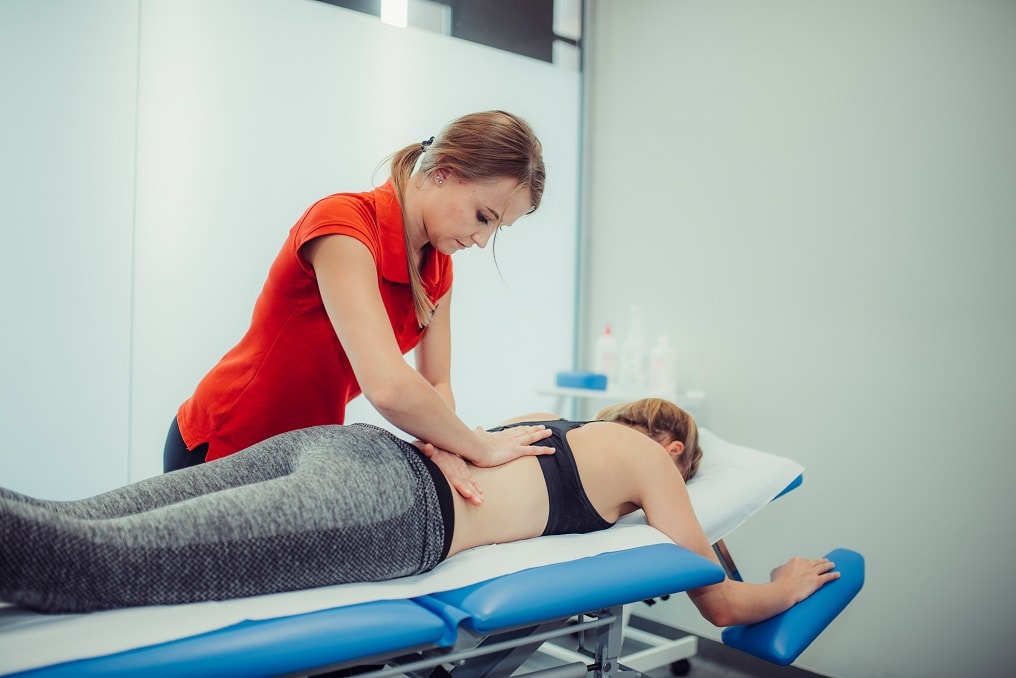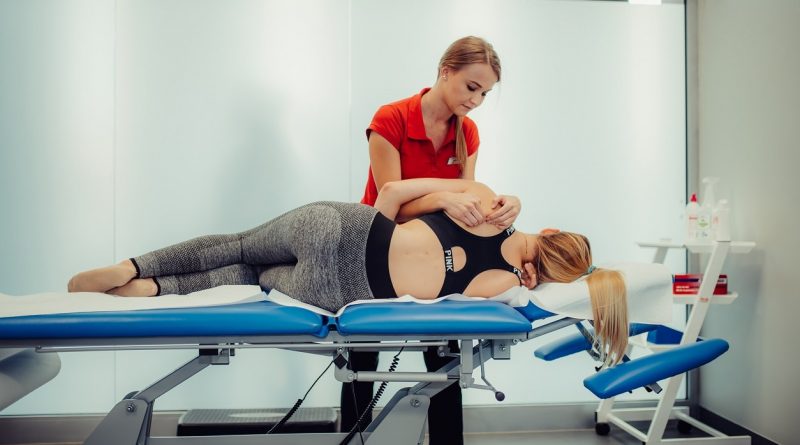Mobilizacja, czy jest tak skuteczna jak mówią?
Mobilizacja bije na głowę swoją popularnością większość metod rehabilitacji. Dlaczego tak się dzieję i czy jest to terapia dla każdego? Czy skuteczność leczenia rękami terapeuty jest aż tak wysoka? Zapytaliśmy naszych specjalistów, skąd bierze się tak ogromna popularność terapii manualnej i czym ona właściwie jest.
Terapia manualna jest stale rozwijającą się metodą leczenia różnego rodzaju dysfunkcji narządu ruchu rękoma terapeuty, stosowaną po przeprowadzeniu szczegółowej diagnostyki pacjenta. Jej celem jest skuteczna i szybka poprawa komfortu życia pacjenta i przywrócenie w jak największym stopniu jego sprawności. Podstawą jest właściwa diagnoza i w tym celu wykorzystujemy specjalistyczne testy, indywidualnie dobrane chwyty, uciski oraz manipulacje, a co najważniejsze do problemu podchodzimy kompleksowo. Wszystkie kroki, jakie wykonujemy w gabinecie mają na celu nie tylko zwalczanie objawów bólu – ale przede wszystkim, leczenie przyczyny jego wystąpienia. Na podstawie przeprowadzonego wywiadu oraz badań fizjoterapeuta dobiera najbardziej skuteczną metodę terapii manualnej do aktualnego stanu funkcjonalnego pacjenta.
Niewątpliwie jest to jedna z głównych przyczyn popularności tej metody – mówi fizjoterapeuta Przemysław Podbielski.
Mobilizacja jest podstawą rehabilitacji
– Fizjoterapeuta Wojciech Solis. – Teraz trochę szczegółów. Przed przystąpieniem do terapii fizjoterapeuta przeprowadza z pacjentem wywiad oraz badanie palpacyjne (badanie dotykiem) i funkcjonalne narządu ruchu. Badanie to odbywa się zarówno w spoczynku jak i podczas ruchów. Terapeuta ocenia wygląd i konsystencję tkanek miękkich, zakres i jakość ruchu elementów kostnych oraz charakter oporów występujących podczas przemieszczania poszczególnych struktur układu ruchu względem siebie. Bada ruchy czynne i bierne kręgosłupa, stawów i ocenia odpowiedzi układu ruchu na czynniki szkodliwe dla jego struktur.
Jakie są wskazania do zastosowania mobilizacji?
– Przemysław Podbielski (P. P.): Lista wskazań jest dość długa.
Ze strony kręgosłupa to m.in.:
- rwa kulszowa
- przepuklina krążka międzykręgowego
- dyskopatia
- bóle głowy
- bóle karku
- „lumbago”, „korzonki”
- whiplash (uszkodzenie odcinka szyjnego po wypadkach komunikacyjnych).
W przypadku dolegliwości ze strony kończyn górnych i dolnych możemy wymienić:
- zespół bolesnego barku,
- zamrożony bark
- łokieć tenisisty
- łokieć golfisty
- cieśń nadgarstka
- ból biodra
- zespół pasma biodrowo-piszczelowego ITBS
- boczne przyparcie rzepki
- kolano skoczka
- chondromalacja rzepki
Terapia manualna przynosi doskonałe efekty w stanach pourazowych, jak np.
- uszkodzenie, nadwyrężenie mięśni
- skręcenie stawu kolanowego, skokowego
- naciągnięcie, naderwanie, zerwanie więzadeł krzyżowych stawu kolanowego
- naciągnięcie, naderwanie, zerwanie więzadeł pobocznych stawu kolanowego
- uszkodzenie łąkotki
- zwichnięcie / podwichnięcie rzepki
- uszkodzenie stożka rotatorów stawu barkowego
- stany po złamaniu
- stany po unieruchomieniu
Jakie stosuje się metody terapii manualnej?
–Wojciech Solis (W. S.) – Wymieniłbym na początek terapię manualną wg szkoły niemieckiej. Dzięki rozbudowanemu schematowi badania różnicującego fizjoterapeuta jest w stanie, za pomocą szczegółowego wywiadu i badania, odnaleźć zaburzone struktury, stwierdzić stopień ich uszkodzenia oraz przeanalizować mechanizmy pojawienia się dolegliwości. Tym samym stawia hipotezę zaburzenia u pacjenta.
Leczenie polega na zniesieniu dysproporcji w strukturach narządu ruchu i przywróceniu fizjologicznej „symbiozy” pomiędzy stawami, mięśniami i tkanką nerwową.
Przykładowe techniki: mobilizacja stawów, neuromobilizacja struktur nerwowych, leczenie tkanek miękkich tj.: mięśnie, więzadła, ścięgna.
W obszar terapii wchodzi również medyczny trening funkcjonalny z użyciem urządzeń treningowych dostosowanych do problemów pacjenta.

Od niedawna stosujemy również pinoterapię (pinopresurę). To nieinwazyjna metoda polegająca na stymulacji obszarów na skórze człowieka.
Metoda zaliczana jest do terapii odruchowych, gdzie wykorzystuje się procesy samonaprawcze organizmu. Przy pomocy miedzianych gwoździ (zwanych pinami) oraz noży (katów) uciska się i stymuluje określone punkty na ciele. Należy zaznaczyć, że w pinopresurze skóra nie jest przebijana. Bodźcowanie skóry pobudza pewne ośrodki w mózgu. Dzięki temu nasz układ mięśniowy, czy też więzadłowy odbiera sygnały z odpowiadających im części mózgu, co prowadzi do odruchowego rozluźnienia zgromadzonych napięć i zmniejszenia bólu.
Pinoterapia ma szerokie zastosowanie w różnego rodzaju schorzeniach o podłożu ortopedycznym i neurologicznym.
Polecana jest w takich przypadkach jak:
- bóle mięśniowo-powięziowe,
- ból głowy,
- bóle kręgosłupa szyjnego, piersiowego i lędźwiowego,
- bóle przeciążeniowe,
- stany pourazowe i pooperacyjne,
- ograniczenia zakresu ruchów w stawach.
P. P. – Wartą uwagi jest metoda FDM (Fascial Distortion Model) – bardzo skuteczny i oparty na dowodach system diagnozowania i leczenia urazów mięśniowo-szkieletowych.
Ten system leczenia jest oparty na sześciu odkształceniach powięziowych, z których każde posiada specyficzny opis charakteru bólu. Kluczowym elementem diagnostycznym jest język ciała pacjenta, czyli opis dolegliwości bólowych jakie dokuczają. Fizjoterapeuta posiadający odpowiednią wiedzę, jest w stanie trafnie ocenić przyczynę bólu i dobrać odpowiednią terapię.
Terapia narządów wewnętrznych jamy brzusznej
Opisując terapie manualne nie sposób pominąć terapii wisceralnej. Jest toterapia manualna narządów wewnętrznych jamy brzusznej, mająca na celu przywrócenie ich prawidłowego napięcia, elastyczności oraz ruchomości. Praca poprzez system narządów wewnętrznych, który posiada liczne anatomiczne i funkcjonalne połączenia z innymi strukturami znajdującymi się w ciele człowieka, pozwala na skuteczną ocenę oraz likwidowanie różnych schorzeń pacjenta.

Problem z funkcjonowaniem narządu wewnętrznego może wpływać na problemy z przyczepami tego narządu, co znowu może powodować ból i zwiększać obronne napięcie mięśniowe. Napięcie to także może generować ból i dawać początek problemom stawowym. Taki łańcuch przyczynowo-skutkowy może funkcjonować również w drugim kierunku, prowadząc do tego, że nierozwiązany problem stawowy stanie się przyczyną problemu z funkcjonowaniem np. żołądka.
W. S. – Jest niezwykle ważne, aby umieć oceniać wpływ problemów wisceralnych na biomechanikę kręgosłupa oraz stawów obwodowych. Doświadczenia terapeutów pokazują, iż większość chronicznych problemów bólowych, które mają swój przejaw w zaburzeniach ruchomości stawowej oraz powięziowej, ma wiele powiązań z narządami wewnętrznymi.
Komu może pomóc terapia wisceralna?
Wskazaniem do terapii wisceralnej są m.in.:
- przewlekłe i ostre bóle głowy i kręgosłupa,
- specyficzne problemy przewodu pokarmowego, np. zespół drażliwego jelita, nerwice żołądka itp.,
- zespoły bólu rzutowanego,
- zespoły pseudokorzeniowe,
- niespecyficzne bóle kręgosłupa,
- nietrzymanie moczu i stolca,
- zaparcia,
- bolesne miesiączki,
- problemy obrzękowe oraz wysiękowe,
- żylaki odbytu oraz kończyn dolnych,
- niektóre bóle stawów obwodowych,
- wspomaganie leczenia chorób układu oddechowego.

Dodam jeszcze, że na zabiegi wymagane jest skierowanie. Pacjenci korzystający z usług odpłatnych, mogą bezpośrednio udać się na wizytę do fizjoterapeuty w celu ustalenia planu zabiegów. Pacjentom, którzy zdecydują się na leczenie nieodpłatne w ramach NFZ, wystarczy skierowanie na rehabilitację od lekarza pierwszego kontaktu lub specjalisty np. ortopedy czy neurologa.
Dziękujemy za rozmowę.

